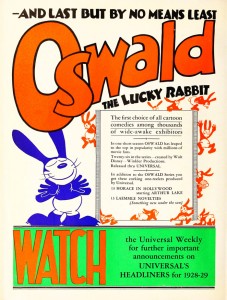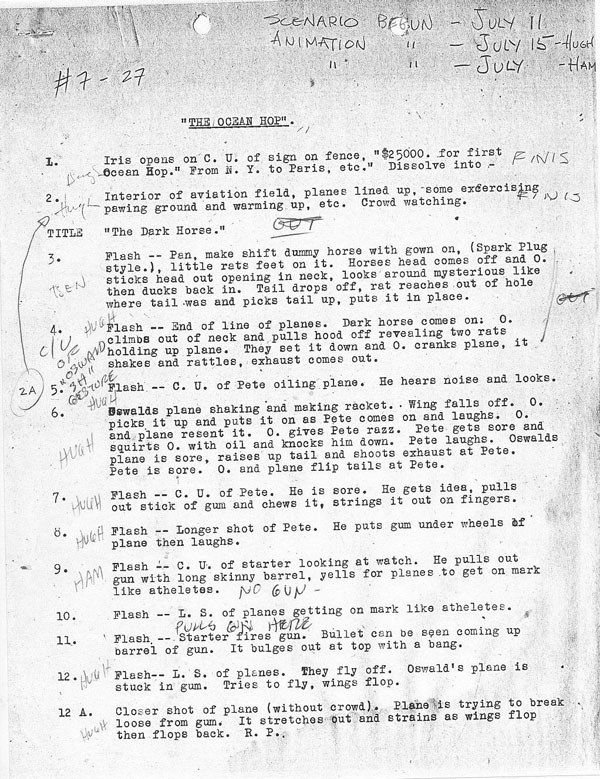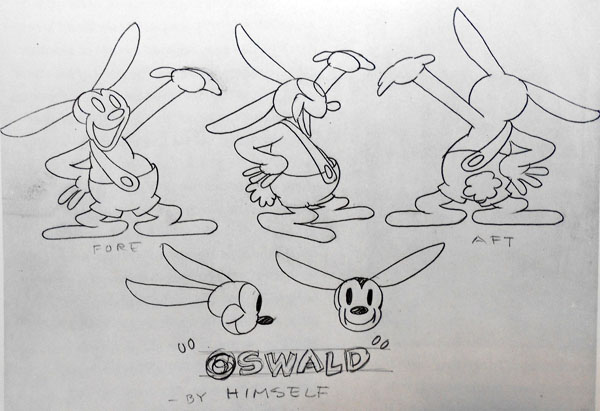 This week’s breakdown features everyone’s favorite lucky rabbit!
This week’s breakdown features everyone’s favorite lucky rabbit!
Oswald the Lucky Rabbit gained newfound popularity when Disney reclaimed the rights to the character, and his original 26 cartoons, in 2006. Producer Charles Mintz seized the rights nearly 80 years ago, but the Winkler and Lantz-produced entries are now owned by Universal. All known surviving Disney Oswald shorts appeared on a Walt Disney Treasures DVD package the following year, and Oswald plays a pivotal role in the Epic Mickey video games, released in 2011 and 2012. Miraculously, four previously lost Oswald titles have re-surfaced since the DVD’s 2007 release — Poor Papa (the first Oswald produced, but withheld from release until 1928), Empty Socks, Africa Before Dark, and Hungry Hoboes. Here’s hoping more will be found!
The drawing and movement in the Oswald series show a definite refinement compared to the earlier Alice films acquired. It didn’t stop Disney and his artists from getting inspiration from their earlier films. Oswald using a dachshund to float high up into the sky using balloons in Ocean Hop is lifted from the earlier Alice’s Balloon Race, where Julius the Cat does those actions exactly.
There was something different in character comedy of this series. The pantomime acting in the Oswald cartoons became more pronounced, and was communicated with suitable poses and actions. In this cartoon, after Oswald fails to get the weary dachshund to continue flying, he crosses his arms in front of his body, in a gesture of frustration. That gesture would be reprised in early Mickey Mouse cartoons. The Oswald series enjoyed contemporaneous popularity throughout its run and captivated East Coast animators that would “seek them out and study them,” as Dick Huemer recollected.
 Disney and his artists took inspiration from aviator Charles Lindbergh’s historic non-stop flight from New York to Paris that occurred on May 20-21, 1927. The scenario and animation for Ocean Hop commenced by July. The primary animators on this cartoon are Ub Iwerks, Hugh Harman, Rollin “Ham” Hamilton, and Ben Clopton, Ub’s assistant. All but Iwerks would leave the studio bankroll by May 1928 to join Winkler Pictures and produce more Oswald cartoons under Charles Mintz. The three animators wanted to break away from Disney’s uncompromising authority, but Iwerks, still devoted to the studio’s success, continued on to develop Mickey Mouse and the Silly Symphonies. He left the studio on January 25, 1930, after signing a contract with distributor Pat Powers to run his own animation studio, creating a series of Flip the Frog cartoons (coming soon in HD near you!).
Disney and his artists took inspiration from aviator Charles Lindbergh’s historic non-stop flight from New York to Paris that occurred on May 20-21, 1927. The scenario and animation for Ocean Hop commenced by July. The primary animators on this cartoon are Ub Iwerks, Hugh Harman, Rollin “Ham” Hamilton, and Ben Clopton, Ub’s assistant. All but Iwerks would leave the studio bankroll by May 1928 to join Winkler Pictures and produce more Oswald cartoons under Charles Mintz. The three animators wanted to break away from Disney’s uncompromising authority, but Iwerks, still devoted to the studio’s success, continued on to develop Mickey Mouse and the Silly Symphonies. He left the studio on January 25, 1930, after signing a contract with distributor Pat Powers to run his own animation studio, creating a series of Flip the Frog cartoons (coming soon in HD near you!).
The lion’s share of footage for Ocean Hop is given to Hugh Harman. While he is more prominent for establishing Warner Bros. and MGM into the animation business, with partner Rudy Ising, his animation on the Oswald series is remarkable. A certain fluidity that highlights the wonderful posing of the characters often rivals Iwerks’ best work in the series. For instance, his sequences of Pete sneaking over to place wads of gum under the wheels of Oswald’s plane ─ and the resulting effect when it struggles to become airborne─ attest to his abilities as an animator. Harman is also credited for the lettering of the sign on the opening iris-in. Rollin Hamilton’s handling of Oswald, in stark contrast, is crude, but his acting abilities as an animator are undeniable. He uses pantomime to a great effect in scene 19, when Oswald makes a gesture for the little rats to blow up a balloon. Intriguingly, key animator Ub Iwerks has little footage in this cartoon. Scene 24, with Oswald and the dachshund rotating up into the sky, is a difficult assignment that only an animator with Iwerks’ mechanical precision could implement.
 In 1931, Walter Lantz re-issued several of the early Disney Oswalds and inserted musical scores by James Dietrich. In addition, he re-shuffled sequences and omitted some altogether. The original negatives for the Disney Oswalds weren’t preserved, so the Lantz re-issues are some the only copies that exist. In general, the re-issue for Ocean Hop switched Putrid Pete’s introduction to occur before Oswald enters with the “Dark Horse” cover (inspired by Spark Plug, Barney Google’s racehorse, as noted on the cutting continuity). Originally, Oswald was introduced, and then Putrid Pete’s scene happened. The breakdown video places the two sequences as originally intended; hence, the whimsical Robert Israel soundtrack doesn’t quite match up most of the action during those portions.
In 1931, Walter Lantz re-issued several of the early Disney Oswalds and inserted musical scores by James Dietrich. In addition, he re-shuffled sequences and omitted some altogether. The original negatives for the Disney Oswalds weren’t preserved, so the Lantz re-issues are some the only copies that exist. In general, the re-issue for Ocean Hop switched Putrid Pete’s introduction to occur before Oswald enters with the “Dark Horse” cover (inspired by Spark Plug, Barney Google’s racehorse, as noted on the cutting continuity). Originally, Oswald was introduced, and then Putrid Pete’s scene happened. The breakdown video places the two sequences as originally intended; hence, the whimsical Robert Israel soundtrack doesn’t quite match up most of the action during those portions.
A missing sequence in this cartoon involved Oswald’s dachshund falling into the engine of a taxicab that two Frenchman are operating; a string of sausages emanate from the exhaust pipe. While the gag seems grotesque, it is no more disturbing than similar subject material present in Alice’s Mysterious Mystery, Dog Gone with Mutt and Jeff (both released in 1926), or the live-action comedy Ham and the Sausage Factory (1915).
The animator identifications – except the first three scenes — placed on the left of the scene descriptions in the original cutting continuity, come from Mark Kausler. The breakdown video credits Rollin Hamilton for scene 19 instead of Ben Clopton, since the style of Ham’s animation is comparable to other scenes attributed to him. Scenes 20 and 23 (assigned as “Hugh/Ham”) are also credited to Hamilton for the same reason. Additional notations on the document tend to differentiate from the original version to the Lantz re-issue, and to give notice on other scene details.
Enjoy this week’s breakdown video (but don’t wrap your head around too much on why these characters don’t wear goggles or scarves during this air race!)




(Thanks to Mark Kausler and Michael Barrier for their help.)


 DEVON BAXTER is a film restoration artist, video editor, and animation researcher/writer currently residing in Pennsylvania. He also hosts a
DEVON BAXTER is a film restoration artist, video editor, and animation researcher/writer currently residing in Pennsylvania. He also hosts a 





















































































“(but don’t wrap your head around too much on why these characters don’t wear goggles or scarves during this air race!) ”
As if that was remotely close to most unreal thing that happened in this cartoon. I’m still trying to wrap my head around how Oswald was able to outrace Putrid Pete while riding a floating dachshund while Pete was piloting a then-modern airplane.
In relation to this cartoon, Walt Disney would later make his first Mickey Mouse cartoon, Plane Crazy, a year later with a similar Lindy inspiration and beginning with an airplane that looks almost exactly like the one Oswald uses in this cartoon (a crate with wings and broom for a rudder).
“Funny animal” cartoon characters look better when they’re not fully dressed the way a human would be (contrast with the bland suburban Mickey Mouse from the late 40s and 50s) but goggles and scarves are such a symbol of an early 20th century aviator (like a tall hat and apron for a chef) that it’s weird to see them without any.
Other observations: The lanky Oswald on the title card looks quite freaky compared to the more appealing design used in the cartoon itself. And why does a flight from New York to Paris take you North-West? (judging by the sign pointing to Paris and the North Pole!)
The gum sequence would be reused by Iwerks in Spite Flight starring Willie Whopper
Haven’t seen all the newly discovered Oswalds, but this has always been my favorite of the Disney silents.
Devon, these Breakdowns are always a treasure! Can’t tell you how grateful I am, and I know others too, that you compile these videos and posts. And Ocean Hop’s been an old favorite of mine. What’s not to love, with its bizarre Iwerks-Hamilton wiener-dog Balloonplane. Next time I go to Paris I’d like to travel this way, Vive le Oswald.
I enjoy reading about these cartoons, especially since I can no longer appreciate the cartoons themselves, but I would imagine that the gum sequence would be quite effective just remembering how scenes involving, say, gooey mud looked in Harman’s HAPPY HARMONIES. I’m certain that Harman added all kinds of interesting touches as he did in the later talkie MGM series. I don’t recall how the similar scene looked in the FLIP TEH FROG cartoon, but I will say that I very much look forward to those coming in fully and diligently restored HD real soon!
I’m guessing the reason the characters don’t have goggles or scarves is because it wasn’t in the animation budget. Those things take time to draw, and Disney didn’t have that kind of money yet.
This post was a real treat, thank you. I’m glad that some of the early entries in the Oswald series were reissued so that they survive today, but it’s frustrating that some scenes were cut. Not too much was cut from this one, but I’d like to see the dachshund’s gruesome end and the mechanics ‘acting Frenchy”! Great to read the cutting continuity, it’s interesting to see what species the animals are identified as – Pete, who look a little like a wolf in some scenes ,is identified as a bear, while I thought were mice are actually rats).
The crowd in the early scene with the exercising aeroplanes is lifted from the ending scene of “Alice the Firefighter”.